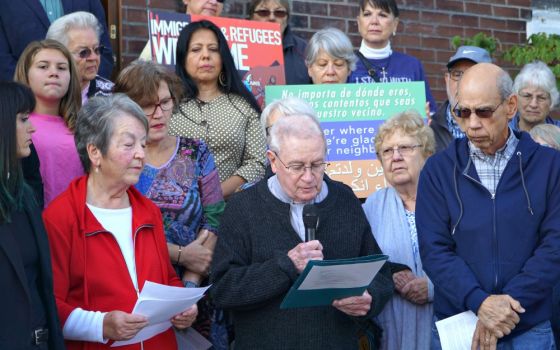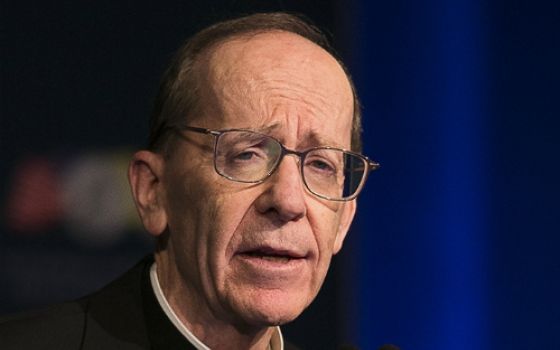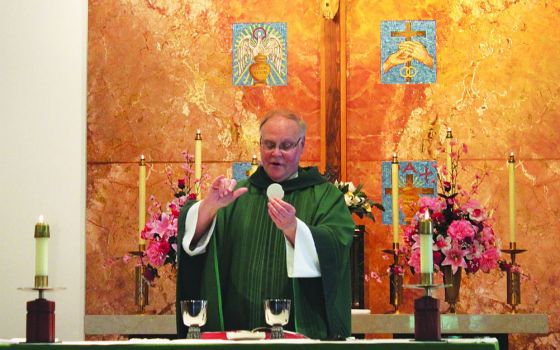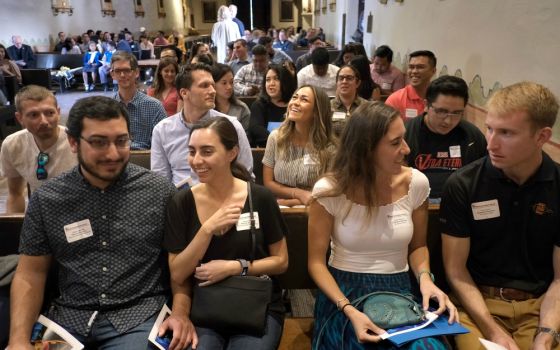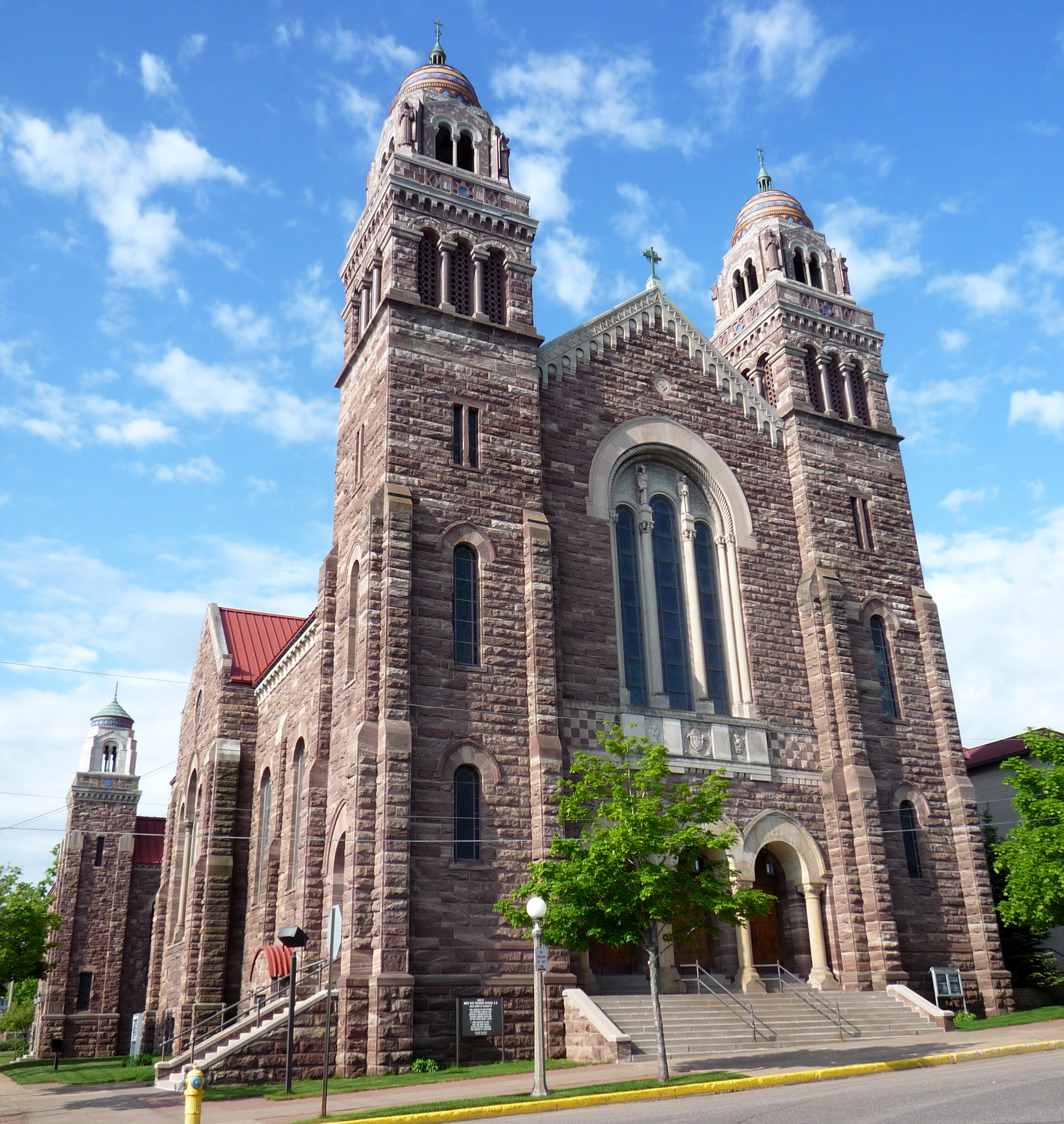
Michigan's rustic Upper Peninsula is roughly three-quarters forest.
Marquette Bishop John Doerfler, who came to upper Michigan in 2014 from the diocese of Green Bay, Wis., wants to hear the woods echo with the transcendent sounds of Gregorian chant. The goal: "to give God the best, most beautiful musical expression that we can offer him as we sing the Mass," Doerfler wrote in a letter to his priests in the diocese in January.
To bring that about, Doerfler said that by 2020 all 94 parishes and missions in his diocese will be chanting at least parts of the Mass. The Kyrie, Sanctus and Agnus Dei will be sung and the Communion antiphon will be chanted. An approved diocesan hymnal will be implemented by 2017, with other hymnals verboten.
A series of liturgical music workshops and seminars will be offered in the meantime to get parishes on board.
In a phone interview with NCR, Doerfler said his unusual initiative -- most bishops simply permit a wide range of church-approved hymnals -- is intended to promote Pope Francis' emphasis on evangelization.
"Music is a key part of the Sunday liturgy," he said, arguing that if fallen-away or potentially new Catholics experience good music at Mass, they will be more likely to return.
Doerfler's letter is a follow-up to a more extensive 2013 pastoral letter written by his predecessor, Bishop Alexander Sample, now archbishop of Portland, Ore. That letter, titled "Rejoice in the Lord Always," had some critical things to say about much contemporary church music, including a statement that "some hymns in approved hymnals, music issues and misallettes do not reflect Catholic theology and should not be used."
Sample did not spell out which hymns in particular violate church theology. But it is evident that Sample was, at least at that time, on the frontlines of what some refer to as the Catholic liturgy wars.
He has been joined by a cadre of bishops. Bishop Robert Morlino of Madison, Wis., wrote a column in his diocesan newspaper in 2011 criticizing “All Are Welcome,” the popular hymn written by Marty Haugen, for lyrics considered overly hospitable to those who do not live church teaching. Morlino said the hymn should not be used in Sunday worship.
Francis can be counted as largely a noncombatant in the liturgy wars. He has not made an issue of liturgical music or rubrics, except occasionally suggesting simplicity and emphasis on a direct Gospel message. There was a wide variety of musical expressions in his visit last year to the United States, including chant, contemporary hymns, African-American Gospel and Latino music, along with a pop music concert in Philadelphia.
But Pope Benedict XVI clearly preferred liturgical chant and other more traditional forms. During Benedict's reign, a group of American bishops issued statements intended to push parish liturgical music away from contemporary sounds to a greater emphasis on chant as the norm of liturgical worship. In some quarters, the movement was referred to as "the reform of the reform" of liturgical changes implemented after the Second Vatican Council (1962-65).
While Sample offered some critical language in his pastoral letter, his implementing successor in Marquette has taken a gentler tack. Doerfler said his proposed Marquette hymnal will include about 300 pieces, ranging from traditional favorites such as "Holy God, We Praise Thy Name," Gregorian chant-style antiphons, and more contemporary pieces such as "Be Not Afraid."
"We are not banning music," he said. His goal, rather, is "to enhance what parishes are already doing."
The addition of chant will improve liturgical music in the diocese and it is accessible in style for even the smallest of parishes, said Doerfler. There will be ongoing education about the changes as the diocese moves to full 2020 implementation.
"There are so many things about chant that add to the transcendent and a sense of the mystery. But I am not saying that chant should be the only thing we should be doing," the bishop said.
"There's a misperception that music is either good or bad because it's old or new. It's a case of both/and rather than either/or," he said.
Benedictine Fr. Anthony Ruff, a liturgical music expert and theology professor at St. John's University in Collegeville, Minn., counts himself as appreciative of Gregorian chant, which is used in his own monastic community. But how effective it will be as a diocesan-wide mandate is another issue entirely, he told NCR.
"We do Latin chant in the monastery. It's great," he said. But there are questions about whether small parishes will have the resources to do chant well, and whether a diocese can gather together copyrights for a hymnal from publishers who have their own products to promote.
Ruff suggested that dioceses look to the U.S. bishops' 2007 document "Sing to the Lord" as the basis for reflection on liturgical music.
That document begins with expressing concern about how the worship community can best pray together. That can include chant, but also contemporary hymns as well, along with music that is part of the culture of immigrant groups, particularly Africans, Asians and Latinos.
The bishops' document is appreciative of Gregorian chant and other traditional forms, but emphasized that Sunday worship can be open to all kinds of musical styles.
"The Church has not adopted any particular style of art as her own. She has admitted styles from every period, in keeping with the natural characteristics and conditions of peoples and the needs of the various rites," the bishops' document stated.
It added: "The Church has consistently recognized and freely welcomed the use of various styles of music as an aid to liturgical worship."
[Peter Feuerherd is a professor of communications and journalism at St. John's University in New York and contributor to NCR's Field Hospital blog.]

